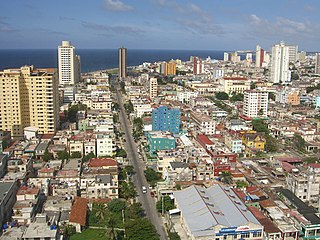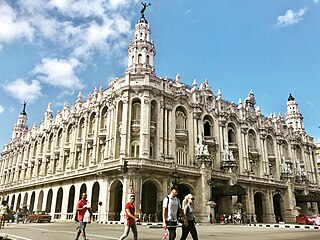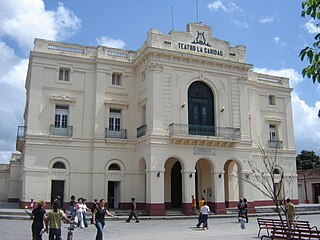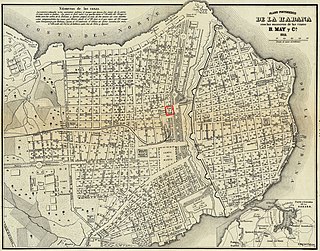
Havana is the capital and largest city of Cuba. The heart of the La Habana Province, Havana is the country's main port and commercial center. It is the most populous city, the largest by area, and the second largest metropolitan area in the Caribbean region. The population in 2002 was 2,137,847 inhabitants, and its area is 728.26 km2 (281.18 sq mi) for the capital city side and 8,475.57 km2 for the metropolitan zone.

Matanzas is the capital of the Cuban province of Matanzas. Known for its poets, culture, and Afro-Cuban folklore, it is located on the northern shore of the island of Cuba, on the Bay of Matanzas, 90 kilometres (56 mi) east of the capital Havana and 32 kilometres (20 mi) west of the resort town of Varadero.

Santa Clara is the capital city of the Cuban province of Villa Clara. It is centrally located in the province and Cuba. Santa Clara is the fifth-most populous Cuban city, with a population of nearly 245,959.
The guaracha is a genre of music that originated in Cuba, of rapid tempo and comic or picaresque lyrics. The word has been used in this sense at least since the late 18th and early 19th century. Guarachas were played and sung in musical theatres and in working-class dance salons. They became an integral part of bufo comic theatre in the mid-19th century. During the later 19th and the early 20th century the guaracha was a favourite musical form in the brothels of Havana. The guaracha survives today in the repertoires of some trova musicians, conjuntos and Cuban-style big bands.

Miramar is a residential district of the municipality of Playa, in the city of Havana.

Old Havana is the city-center (downtown) and one of the 15 municipalities forming Havana, Cuba. It has the second highest population density in the city and contains the core of the original city of Havana. The positions of the original Havana city walls are the modern boundaries of Old Havana.

Gran Teatro de La Habana is a theater in Havana, Cuba, home to the Cuban National Ballet. It was designed by the Belgian architect Paul Belau and built by Purdy and Henderson, Engineers in 1914 at the site of the former Teatro Tacón. Its construction was paid for by the Galician immigrants of Havana to serve as a community-social center. Located in the Paseo del Prado, its facilities include theatres, a concert hall, conference rooms, a video screening room, as well as an art gallery, a choral center and several rehearsal halls for dance companies. It hosts the International Ballet Festival of Havana every two years since 1960.

The Teatro Nacional de Cuba is a theatre building in Havana, Cuba, on Plaza de la Revolución.

Manuel Rodulfo Tardo was a Cuban artist.
Eliseo Valdés Erustes is a Cuban artist specializing in sculpture, painting, and drawing.

Teatro de La Caridad or Teatro La Caridad, located in Santa Clara, is one of the few remaining colonial theatres in Cuba. It is a National Monument of Cuba.

The Lonja del Comercio building in Old Havana, Cuba served as the stock exchange in the capital until the 1959 Cuban Revolution. Today, it is an office building.
The following is a timeline of the history of Havana, Cuba.
Leandro Soto was a Cuban-American multidisciplinary visual/installation and performance artist. He was also a set and costume designer for theater and film. Soto studied at Escuela Nacional de Arte National Art Schools (Cuba) and Instituto Superior de Arte, University of Havana. As an educator he taught and lectured at various Higher Education institutions in the U.S. and abroad. Soto also founded a creative workshop, El Tesoro de Tamulte, in Tabasco, Mexico, from which professional artists emerged.
The following is a timeline of the history of the city of Camagüey, Cuba.
The following is a timeline of the history of the city of Matanzas, Cuba.

The Teatro Tacón opened in 1838 in Havana, Cuba. Its auditorium contained 2,750 seats. It was built by Pancho Martí, a businessman from Barcelona who moved to Havana, and named after Miguel Tacón y Rosique, Governor of Cuba from 1834 to 1838. In 1847 Bottesini's opera Cristoforo Colombo premiered there. By 1855, so many people attended events that the city issued parking regulations for carriages on performance nights.
Alicia Leal Veloz is a Cuban painter. She was born in Sancti Spíritus, Cuba.

The Galería Pedro Esquerré, of the Provincial Council of Fine Arts and Cultural Heritage of Matanzas, is a Museum and Art Center, in Matanzas, Cuba.














